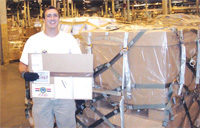packed with pride

It's not too often that a supervisor in a distribution center puts his life in the hands of the workers on the line.
Once a month, Master Sergeant Sean Wilson does just that.
Wilson is team leader and master rigger—a certified parachute packing specialist—on a line at the Defense Distribution Depot Susquehanna Pennsylvania (DDSP), the military's sprawling distribution complex near Harrisburg, Pa. His crew packs parachutes for military use. And once a month, Wilson takes one of those parachutes—selected randomly by somebody outside the team—boards an aircraft that takes him thousands of feet above the base, and jumps out.
Wilson's trust in his team, and the team's commitment to ensuring that every parachute is reliable, stands as testament to the ethic that pervades the DDSP complex. At this facility, the phrase "good enough for government work" means something far removed from the pejorative it has become over the years. The phrase entered our lexicon during World War II, when something that was "good enough for government work" met the most rigorous of standards: You could literally stake your life on it. And that's precisely the standard that employees at DDSP hold themselves to today.
Making a difference
DDSP is the headquarters location of the Defense Distribution Command, which is the physical distribution arm of the Defense Logistics Agency (DLA), and the largest distribution depot operated by the Department of Defense. It sprawls over 380 acres, split between two locations near Harrisburg, providing military and commercial repair parts, clothing and textiles, medical supplies, and industrial and electronic components to military customers throughout the United States and around the world. DDSP has over $10 billion worth of inventory on the shelf, with more than 870,000 unique items in stock spread across over 1 million storage locations. Compare that to Wal-Mart, which systemwide handles on the order of 120,000 SKUs.
DDSP, with more than 3,700 military and civilian employees, is the largest of the 25 distribution centers operated by DLA both here and abroad, and it supports a customer base that includes units in Europe, Africa, Central and South America, Southwest Asia, and the eastern half of the United States. The facility houses 9.4 million square feet of covered storage spread across 58 warehouses, with the largest building, the Eastern Distribution Center, providing 1.7 million square feet alone.
In short, it is a distribution goliath, shipping billions of dollars of supplies to locations around the world every year. And it has one customer: the U.S. military. Crucially, it is the DC supporting operations in Southwest Asia, where the United States continues to fight wars in Iraq and Afghanistan.
That knowledge makes employees at the facility—40 percent of whom are veterans—take their jobs very seriously. As you might expect, the relationship between workers and management in the unionized facility is different from what might be found in DCs in the private sector. The same might be said of the employees' attitude toward their work.
Take Bob Keeney, supply specialist and former vice president of Local 2004 of the American Federation of Government Employees, AFL-CIO, for example. Keeney, a military veteran like so many of his peers, has been in the warehouse for 32 years. His father-in-law came back from Korea and went to work there, and Keeney did the same thing when he got out of the Navy in 1974. His particular expertise is in the nasty stuff that moves through a military warehouse: explosives, radioactive materials, fumicides, and other sorts of ugly things.
While talking, he suggests that we shift the conversation after hours to a bar called Julie's near the DC, and he offers to buy me a beer. He is dressed in a T-shirt and jeans; the handiwork of tattoo artists adorns both arms. We get on the topic of continuous improvement and DDSP's current lean initiative. It turns out that Keeney likes lean. "Partnership [between management and the workforce] is the way to do the work ... I look for the day when we have everybody on board. The old way was adversarial," he says. Now, however, "you become like a cog. You understand where you are on that wheel. You try to make it easy for the next guy."
He sees the work as important. "I enjoy making a difference, trying to do good," he explains. "We have obligations to the soldiers in the field, to the agency. If you don't believe in what you are doing, you're not going to be a good employee."
Focused on the warfighter
The same commitment comes across in conversations with senior management. Ed Visker has been the deputy commander of the DDSP since June 2006. Visker, who has a B.S. in banking and finance, as well as a couple of master's degrees, including one in logistics systems management from the University of Southern California, has spent 30 years in the logistics business, primarily with the military. Before coming to DDSP, he reached the rank of colonel in the U.S. Army. He served in the Airborne, and his tour included deployment to Iraq during the first Gulf War and time in Special Operations. He's got the qualifications and the experience to be a senior manager in any global distribution business.
Visker first came to DDSP as a soldier. "As a young platoon leader and company commander, I was in a general supply company. We used to bring the unit here to train. We helped clear the footprint for this building that we're in right now. We brought in all our rough-terrain forklifts and cranes and set up shop down by the pond for the month of February. We emptied out the old sheds that used to be sitting here."
He describes how he sees the mission of DDSP and how to accomplish it. "I don't know that anybody would tell you that they're a warehousing professional. We are supporting the warfighter," he says. "I think you would get that out of just about anybody you talk to. We're really focused on the warfighter. I share with them pictures that I brought back from my time in the desert to remind them that these guys are out at the pointy end of the spear and it's important."
That perspective drives the operation. "We're a strategic platform.We need to think bigger," he says. "We're focused on three basic values: respect for people, customer focus, and continuous improvement. It gets the folks on the floor more engaged. It's largely about relearning: How do we manage the organization? How do we lead people in the organization?"
Lessons from the private sector
DDSP is taking lessons from the private sector. For example, managers have visited a Wal-Mart DC about 100 miles from their facility to see how the retail giant employs technology. They have visited Toyota and adopted many of the fundamentals of the Toyota Production System to drive continuous improvement.
Their success in imbuing that sense of mission throughout the operation reveals itself in a conversation with a group of DDSP employees sitting around a conference table. The "youngster" is probably in his late 30s, but most of them qualified for AARP a long time ago. Some are white collar, some blue collar, but they're all veterans.
Many retired after a career in the military and came to the DDSP, while others did a tour or two. Their service experience spans all of the military departments. They have tales that range from the Vietnam War to Southwest Asia, covering a lot of ground in between.
The conversation drifts toward why they do what they do for a living now. One reminisces about what it was like when he was in the field and heard the magic words, "Your supplies are here." He's a middle manager now, a believer in getting out with his team. He offers, "Every day I tell them about the men and women we're serving. My heart is a heart of compassion for the mission. I don't ever give it up."
Another is more matter of fact. "They need it when they need it. That's what drives me," he says. "Some of them are giving their lives."
A late arrival joins in, asserting, "I'm willing to do whatever it takes to get that soldier what they need."
He gets a little more introspective, recalling what it was like for him when he came to the DDSP. "I got here and didn't realize what I'd gotten myself into here." He was on the floor one day, looking around, and saw "a section full of caskets. I realized that was going to be the last ride home for some soldiers," he recalls. "My whole mindset changed. People are depending on me."
No magic
The scale of the operation at DDSP is impressive, but the facility really isn't. Some of the buildings date back to World War I, and even the 1.7 million-square-foot building dates back to the mid '80s. There's no magic in the process, or the buildings, or the technology.
What makes DDSP special are the people, the pride, and the intelligence of the leadership that is harnessing the power of those two combined.
The final step in the distribution process at DDSP includes a personal statement from whoever does the final check on the shipment before it leaves the facility. Each shipment going out has a sticker on it, and the sticker is signed by a real person. It reads, "Packed with Pride at DDSP."
Related Articles

Copyright ©2024. All Rights ReservedDesign, CMS, Hosting & Web Development :: ePublishing